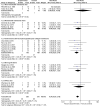Impact of regenerative procedure on the healing process following surgical root canal treatment: A systematic review and meta-analysis
- PMID: 39746110
- PMCID: PMC11695025
- DOI: 10.1371/journal.pone.0312751
Impact of regenerative procedure on the healing process following surgical root canal treatment: A systematic review and meta-analysis
Abstract
Introduction: Different Guided Tissue Regeneration (GTR) procedures, such as membranes, bone substitute materials, and Autologous Platelet Concentrates (APCs), have been applied after surgical root canal treatment (SRCT), which produce different outcomes. This study aimed to evaluate the impact of regenerative procedures on the healing process following SRCT.
Methods: A comprehensive search of PubMed, Embase, Scopus, Cochrane, and the Web of Science found Randomized Controlled Trials (RCTs) published until February 25, 2024. Manual searches were also conducted. Our main outcome was SRCT success or failure after GTR procedures. The Risk Ratio (RR) and failure rate meta-analysis used a fixed effects model with a 95% confidence interval (CI). Subgroup analyses were conducted based on the use of different GTR procedures for varying lesion types in SRCT.
Results: Out of 1,605 records, 16 studies with 690 lesions were included. Overall, GTR procedures significantly improved healing after SRCT in both 2D (RR: 0.50; 95% CI, 0.34-0.73; P < 0.001) and 3D evaluation methods (RR: 0.36; 95% CI, 0.15-0.90; P < 0.001) with no significant difference between the two methods.
Conclusion: GTR significantly improved SRCT healing regardless of the evaluation method used. Combining collagen membranes with bovine bone-derived hydroxyapatite significantly enhanced the healing process. Additionally, GTR procedures significantly improve healing in through-and-through lesions.
Copyright: © 2025 Muthanna et al. This is an open access article distributed under the terms of the Creative Commons Attribution License, which permits unrestricted use, distribution, and reproduction in any medium, provided the original author and source are credited.
Conflict of interest statement
The authors have declared that no competing interests exist.
Figures







References
-
- Berman LH, Hargreaves KM. Cohen’s Pathways of the Pulp-E-Book: Cohen’s Pathways of the Pulp-E-Book: Elsevier Health Sciences; 2020.
Publication types
MeSH terms
Substances
LinkOut - more resources
Full Text Sources
Miscellaneous

